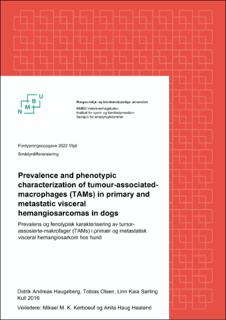| dc.contributor.advisor | Moe, Lars | |
| dc.contributor.advisor | Koppang, Erling Olaf | |
| dc.contributor.advisor | Haaland, Anita Haug | |
| dc.contributor.advisor | Kerboeuf, Mikael M. K. | |
| dc.contributor.author | Haugeberg, Didrik Andreas | |
| dc.contributor.author | Sørling, Linn Kaia | |
| dc.contributor.author | Olsen, Tobias | |
| dc.date.accessioned | 2022-11-03T08:07:56Z | |
| dc.date.available | 2022-11-03T08:07:56Z | |
| dc.date.issued | 2022 | |
| dc.identifier.uri | https://hdl.handle.net/11250/3029707 | |
| dc.description.abstract | Canine visceral hemangiosarcoma (HSA) is an aggressive, malignant tumour associated with a dramatic clinical presentation and a poor prognosis despite multimodal treatment. Macrophages are a part of the innate immune system with a wide range of properties but can roughly be divided into M1 and M2 polarized macrophages, where M1 have a pro-inflammatory role, whilst M2 have an immunosuppressing and tissue-remodelling role. In the tumour microenvironment (TME) there are, amongst other cells, tumour-associated macrophages (TAMs), which have been shown to mostly polarize towards the M2 phenotype. Targeted therapy against TAMs and repolarizing them towards M1 could be a new point of attack in cancer treatment, both in veterinary medicine and human medicine. Dogs have similar cancer forms, live similar lifestyles, and have complex immune systems as humans and are therefore excellent models for comparative oncology research.
We wanted to investigate the macrophage prevalence in dogs with hemangiosarcoma in tumour tissue and surrounding healthy tissue. Using immunohistochemistry, we studied the prevalence and phenotype of macrophages in hemangiosarcoma in dogs, both in the primary tumour and metastases. More specifically, CD204 was used as a general macrophage marker, while CD206 was used as an M2 macrophage marker. We found a significant difference in the total prevalence of macrophages, M2 macrophages, and the relative ratio of M2 macrophages between the tumours and surrounding healthy tissue. There were both more macrophages and M2 macrophages within the tumour than outside, and the macrophages inside the tumour tissue were more often of an M2 phenotype compared with macrophages in the normal tissues. There was no significant difference in total number of macrophages or M2 macrophages between the location of tumours. We also saw a tendency towards higher numbers of M2 macrophages in the normal surrounding tissue in the lungs compared to other organs. However, this difference was not significant.
These results contribute to a better understanding of TAMs distribution and phenotype in dogs with HSA. In the future, dogs with HSA could be used as models to evaluate new therapies targeting TAMs and their polarization. | en_US |
| dc.description.abstract | Hemangiosarkom (HSA) hos hund er en svært aggressiv malign tumor, som er forbundet med en ofte dramatisk klinisk presentasjon og dårlig prognose på tross av multimodal behandling. Makrofager er en del av det medfødte immunforsvaret med en lang rekke funksjoner, og kan grovt deles inn i M1 og M2 polariserte makrofager der M1 innehar en pro-inflammatorisk rolle, mens M2 har en mer immundempende og vevsoppbyggende rolle. I maligne svulster dannes det et mikromiljø bestående av blant annet makrofager, kalt tumor-assosierte makrofager (TAMs). Disse har ofte M2-polarisert fenotype. Målrettet terapi mot TAMs og repolarisering mot M1 kan være en ny angrepsvinkel i behandling mot kreft, som kan være nyttig både for veterinærmedisin og humanmedisin. Hunder får liknende krefttyper som mennesker, de påvirkes av mange av de samme miljøfaktorene, og har et fullverdig og komplekst immunsystem som mennesker og kan dermed være et godt modelldyr for komparativ kreftforskning. I denne studien ønsket vi å se nærmere på distribusjonen av makrofager hos hunder med hemangiosarkom, både i tumorvevet og i omkringliggende friskt vev. Ved hjelp av immunhistokjemi studerte vi forekomsten av makrofager i hemangiosarkom hos hund, både i primærtumor og metastaser. Vi brukte to antistoffmarkører: CD204 og CD206, til å identifisere og karakterisere makrofagene. CD204 er en uspesifikk markør for makrofager, mens CD206 er en spesifikk markør for M2 polariserte makrofager | en_US |
| dc.language.iso | eng | en_US |
| dc.publisher | Norwegian University of Life Sciences, Ås | en_US |
| dc.rights | Attribution-NonCommercial-NoDerivatives 4.0 Internasjonal | * |
| dc.rights | Attribution-NonCommercial-NoDerivatives 4.0 Internasjonal | * |
| dc.rights | Attribution-NonCommercial-NoDerivatives 4.0 Internasjonal | * |
| dc.rights.uri | http://creativecommons.org/licenses/by-nc-nd/4.0/deed.no | * |
| dc.title | Prevalence and phenotypic characterization of tumor-associated macrophages (TAMs) in primary and metastatic visceral hemangiosarcomas in dogs | en_US |
| dc.title.alternative | Prevalens og fenotypisk karakterisering av tumorassosierte-makrofager (TAMs) i primær og metastatisk visceral hemangiosarkom hos hund | en_US |
| dc.type | Student paper, others | en_US |
| dc.subject.nsi | VDP::Landbruks- og Fiskerifag: 900::Klinisk veterinærmedisinske fag: 950 | en_US |

